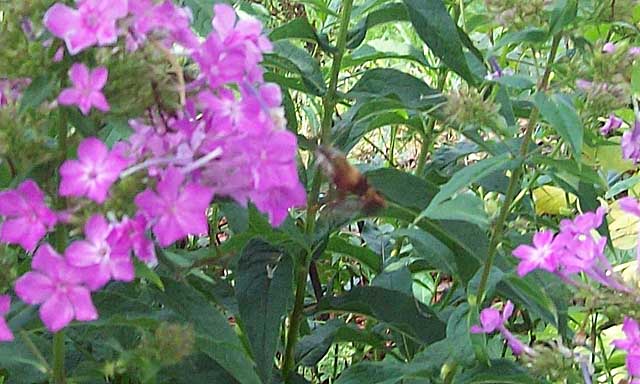Ogle County, Illinois
Sphingidae

Hemaris thysbe, Oregon, Ogle County, northern Illinois,
August 22, 2010, courtesy of Annette Coble
|
|
Created/dedicated as per personal communication with Annette Coble, August 23, 2010 Updated as per James P. Tuttle's The Hawk Moths of North America, August 23, 2010 Updated as per Butterflies and Moths of North America website, formerly USGS, August 23, 2010 |

Hemaris thysbe, Oregon, Ogle County, northern Illinois,
August 22, 2010, courtesy of Annette Coble
Annette writes, "I have seen this moth on my flowers. It is usually out around 6:00 to 7:00 at night. It has the rapid fluttering wings like a hummingbird and is about an inch long. A orangish color and the tail is not pointed but has a fan tail. If you look at the back it looks like a small lobster. I wonder if you know what I am talking about?"
Forty-two Sphingidae species are listed in the USGS for Illinois. Not all of the species are reported (five by USGS as of August, 2010) in Ogle County in northern Illinois. I have added some species which I feel may be present (at least occasionally).
It is hoped that this checklist, with the thumbnails and notes, will help you quickly identify the moths you have encountered.
A "WO" after the species name indicates that I have no confirmed reports of this species in Ogle County, but I (William Oehlke) expect that these moths are present.
Please help me develop this list with improved, documented accuracy by sending sightings (species, date, location), preferably with an image, via email to Bill Oehlke.
Sphinginae subfamily
Smerinthini Tribe:
Macroglossinae subfamilyDilophonotini Tribe:
See Hemaris comparison
to help distinguish the next three species.
|
 |
Eumorpha achemon
USGS,
the Achemon Sphinx:
This moth is confirmed for nearby McHenry County. It is fairly often
reported along the east coast from southern New Jersey
to central Maine. |
 | Eumorpha pandorus WO the Pandorus SphinxIf you have Grape or Virginia Creeper nearby, then you probably have this species. I often get asked to identify larvae from areas where they have not previously been reported. |
 | Amphion floridensis USGS, the Nessus Sphinix: This day flier is widely distributed. If you have Virginia Creeper, you probably have the Nessus Sphinx.Two bright, distinct, narrow yellow bands are often visible on the abdomen. |
 | Darapsa choerilus WO, the Azalea SphinxThey are common in New Jersey and common here on Prince Edward Island. You will often see this species listed as Darapsa pholus, especially in older literature. |
 | Darapsa myron WO, Virginia Creeper Sphinx; Grapevine Sphinx: It is widely reported as far north as southern Maine. If you have the foodplants indicated in the common names, you probably have this species nearby. |
 | Darapsa versicolor WO, the Hydrangea Sphinx: If you have hydrangea growing near a stream, then you may have the Hydrangea Sphinx.However, it probably is uncommon. |
 | Deidamia inscriptum WO, the Lettered Sphinx: The moth's outer margin of the forewing is deeply scalloped. The upperside is light brown with dark brown markings. There is a small black and white spot near the tip. The upperside of the hindwing is orange-brown with a dark brown outer margin and median line. |
 | Hyles gallii WO, the Bedstraw Hawk Moth or Gallium SphinxThis species is not confirmed in Stephenson County, but it might be present. Some years I see them on P.E.I., some years, I do not. |
 | Hyles lineata USGS, the White-lined SphinxAdults usually fly at dusk, during the night, and at dawn, but they also fly during the day over a wide variety of open habitats including deserts, suburbs, and gardens. |
 | Sphecodina abbottii WO, the Abbott's SphinxThis moth is very much under reported on USGS. It is a rapid day flier so is probably not in too many collections. Grape is a popular larval host. |
 | Xylophanes tersa WO, possible stray, generally more southerly, the Tersa SphinxThe upperside of the forewing is pale brown with lavender-gray at the base and has dark brown lengthwise lines throughout. |
Enjoy some of nature's wonderments, giant silk moth cocoons. These cocoons are for sale winter and fall. Beautiful Saturniidae moths will emerge the following spring and summer. Read Actias luna rearing article. Additional online help available.
Eggs of many North American species are offered during the spring and summer. Occasionally summer Actias luna and summer Antheraea polyphemus cocoons are available. Shipping to US destinations is done from with in the US.
Use your browser "Back" button to return to the previous page.
This page is brought to you by Bill Oehlke and the WLSS. Pages are on space rented from Bizland. If you would like to become a "Patron of the Sphingidae Site", contact Bill.
Please send sightings/images to Bill. I will do my best to respond to requests for identification help.
 Show appreciation for this site by clicking on flashing butterfly to the left. The link will take you to a page with links to many insect sites. |
I very much appreciate all the many images that have been sent to me, or of which I have been granted permission to copy and post from other websites. All images on this site remain the property of respective photographers.
If you would like to contribute to the maintenace of this website by sending a contribution to
Bill Oehlke
Box 476
155 Peardon Road
Montague, Prince Edward Island, C0A1R0
Canada
your donation would be much appreciated and would be used for
1) paying for webspace rental;
2) paying for computer maintenance and software upgrades;
3) purchases of additional text reference material (journals and books) in anticipation of expanding the site to a worldwide Sphingidae site;
4) helping to pay my daughter's tuition (completed spring of 2013); with anything left over going to humanitarian aid.
If you are mailing a check from USA, please use $1.10 (2013 rate) postage. Donations can also be made through Paypal via the button below.